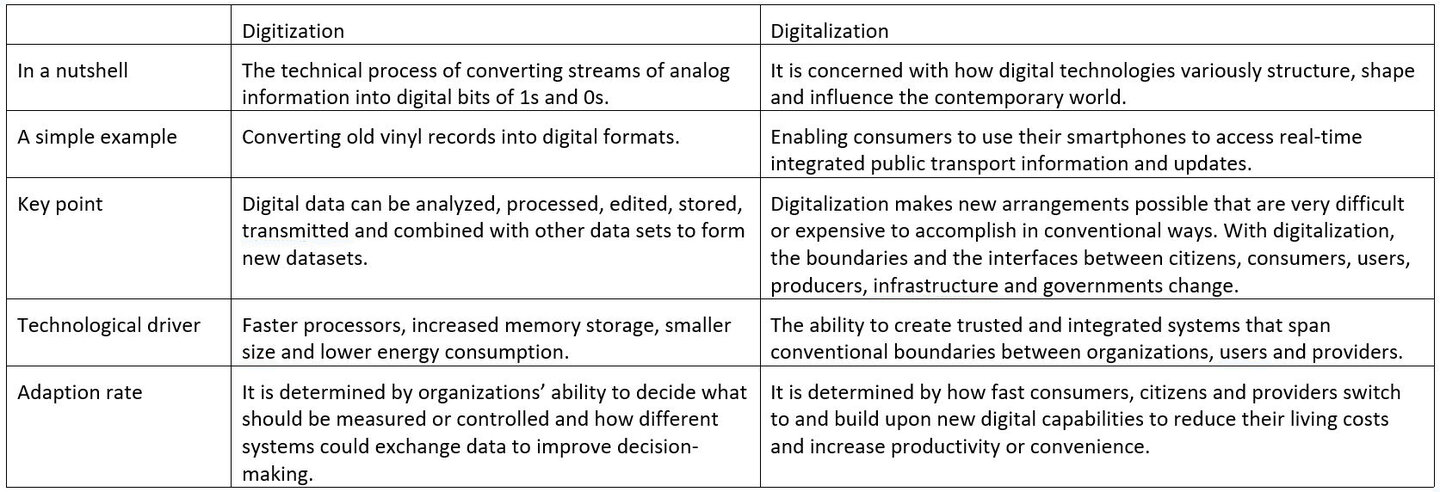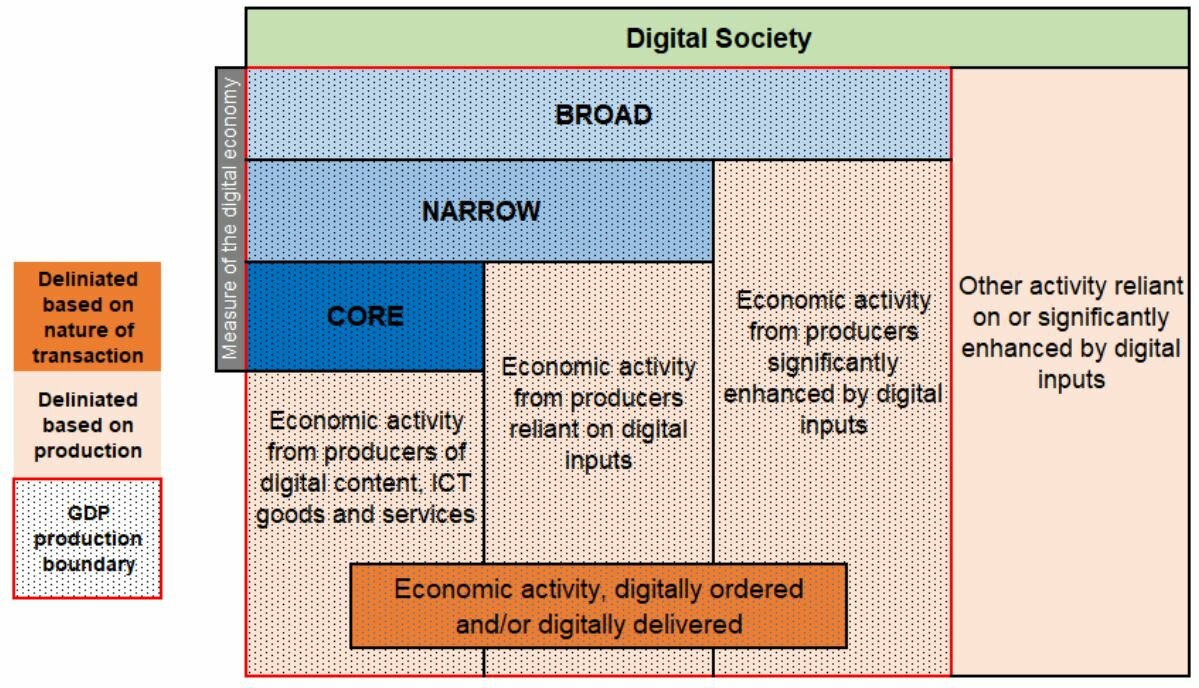In the projects where I work, we are often challenged with figuring out how to describe the interaction of the information and communications technology (ICT) sector with the rest of the economy. In other words, we are grappling with the boundaries between digital goods and services and the rest of the economy.
In our project teams, we often debate the following:
- Do we look at the core ICT sector or the economic activities that rely on ICT goods and services as critical inputs?
- Do we focus on ICT skills or on more traditional sectors that increasingly depend on ICT literacy, or do we focus on economic activities enhanced by ICT?
- Are we trying to support the successful delivery of goods and services based on increasing digital content or are we trying to foster a digital society?
- What do we do with the traditionally less ICT-dependent economic actors and activities?
To explore these questions in our team and with counterparts, it is helpful to use the same terminology. However, when the words digitization and digitalization are used as synonyms, important nuances are lost.
In an earlier blog post I wrote about the differences between digitization and digitalization. Based on the conversations and fieldwork that followed that earlier post, I have created the table below.

In this table, ICT capabilities play an essential role in both digitization and digitalization. However, with digitalization, the focus is more on integrating or connecting systems that currently may be operating separately. It is not just about using digital technologies, but in many cases involves imagining completely new ways of arranging and interacting using digital technologies as an enabler. In most organizations, this requires a willingness to integrate previously closed-off systems and allow consumers, other organizations and maybe even third parties to interact with one’s data and systems.
Exploring measurement frameworks
We need to better understand where each country we work in is on the digital transformation cycle and the relationships between the core services, core skills and the rest of the economy. Where do we start? With a focus on core ICT skills and digital literacy as an extension? Or on systems engineering and management expertise, followed by programs and operators? How do we even know where we are on this pathway when we are faced with unreliable or highly aggregated data in most developing countries? How do we navigate when we can see both tremendous digital advancements and old legacy systems working right next to each other wherever we turn? Is there even a pathway, or must every sector, industry, community and country figure this out based on their context?
Fortunately, many multilateral development organizations have been deliberating on these same questions. The Organization for Economic Cooperation and Development (OECD), various United Nations (UN) agencies, the European Commission, and many others have developed measurement instruments that are constantly refined. The benefit of exploring measurement frameworks is that it requires accuracy and consistency of terminology by their very nature. A possible risk of these reports is that the correlation between key factors may imply causation; but perhaps we can manage that risk if we have a better idea of how things seem to depend on and interact with each other.
Unfortunately, some of the publications by these organizations are daunting to read. For me, the UN agency International Telecommunication Union’s (ITU) and the OECD’s reports are the most accessible. When we align our development work with these international frameworks, measuring and comparing our work with others becomes more manageable.
I want to focus on a publication prepared by the OECD for a recent G20 meeting on measuring the digital economy. This report answered many of the questions that I have been grappling with, which I mentioned above. The OECD report elaborates on five tiers of measurement of the digital economy:
1. The core ICT sector only measures economic activity from digital content producers, ICT goods and services.
2. The narrow measure includes the core ICT sector and economic activity from firms reliant on digital inputs.
3. The broad measure includes the previous two measures as well as economic activity from firms significantly enhanced by the use of ICT inputs.
These first three tiers, when combined, can be referred to as the digital economy.
4. The digital society extends further than the digital economy and incorporates digitalized interactions and activities not measured by GDP and other economic metrics. For instance, it could include free digital platforms and technologies (such as free email addresses for citizens or students, or free internet access in public transport, public buildings or urban areas). These measures are essential for public policymaking by the government.

The OECD also proposes a 5th tier, which offers an alternative way of viewing economic activity by focusing on the meeting points between digital and physical systems.
5. This tier looks at the interfaces where digital and non-digital systems interact or where data is exchanged between digital and non-digital economic activities. A distinction is made between digitally ordered and/or digitally delivered. An example is that I booked my recent flight digitally, but the flight required physical service delivery. I selected my meal option digitally, but the food had to be prepared and delivered physically. Or I had to sign a physical contract for my mobile phone but the mobile service was provided digitally.
When I look at the descriptions of these tiers, I can see where the project activities I am involved with are focused:
- Working with education providers to offer new ICT courses is focused on the 1st tier.
- Supporting a university to improve the ICT content of its engineering programs is in the 2nd tier. The engineering graduates will most likely use computer-aided design, simulation, and ICT management systems wherever they go to work.
- Working with farmers to better use digital technologies to improve their land and water management is probably the 3rd tier. Again, these technologies enhance what they are already doing without becoming ICT experts.
- I wonder whether efforts to improve remote participation in higher education (via e-learning) are in the 4th tier? It makes sense that the benefits of e-learning may be hard to measure using economic metrics; however, providing access to education from anywhere in a country also seems to be an essential enabler to overcome regional and other inequalities.
The 5th tier is the one that had me thinking the hardest. I know that in manufacturing and food processing, many digitization projects often do not draw on core or narrow ICT skills. Usually, process control solutions are provided by equipment suppliers (tier 3) and then maintained by operators trained by the solution providers. Or the process may require entirely new functions to be added to the workplace. For development projects to support tier 5, processes would require a very different technical expertise and intervention logic than we have now.
The 5th tier seems to be the area where the digital economy boundary is constantly being pushed outwards. This means there are changes in services, consumption, regulations and organizations. I feel optimistic that developing countries can jump onto the latest momentum of what is possible in some contexts and then backfill what is missing after mastering something new. Wherever physical and digital systems and data streams interact, there are ongoing contests for alternative ways to integrate, arrange, regulate and innovate these different systems. At the same time, this is where people excluded from these advancements may be pushed aside and where we as development practitioners must pay careful attention.
Let me conclude with a few thoughts about the questions I posed initially.
- To support digital transformation, we cannot focus only on selected core and narrow ICT goods, services and skills. To me, it now seems questionable to focus on ICT as a sector.
- ICT literacy is quickly becoming an essential requirement for most new jobs. Many existing workers and marginalized populations need to have access to digital literacy education or they will face exclusion from future job opportunities. However, when some processes are digitized, operators may need literacy and additional on-the-job training to operate a machine or a process, not necessarily digital literacy.
- The challenge is that when some digital functions are added to existing organizations, it often requires the addition of new competencies that displace existing competencies. For instance, digital clothing design and pattern preparation displaces many physical design, cut-make-and-trim and other pattern preparation tasks.
- Many existing professions, occupations, and services are increasingly enhanced by ICT capabilities and technologies. That means the boundary around economic activities in the 3rd tier is expanding. As examples, consider engineering, healthcare, education, public management and manufacturing activities.
- The digital transformation and integration of public infrastructure can accelerate the digital transformation of societies by enabling new (local) markets for ICT goods and services, reducing the cost of access to public services for consumers, and improving the management and delivery of public services.
If we think about digitization in the rest of the economy, beyond the narrow ICT sector, then manufacturing and food production come to mind. While many machines, process technologies and electronic equipment have changed over the last twenty years to include capabilities that allow for data exchange, monitoring or remote control, very few companies use these built-in capabilities effectively. It now seems evident that the obstacle is not a shortage of ICT technicians that can extract valuable data from equipment, but rather a lack of understanding of how the digitization of processes can result in cost savings, improved maintenance, reduced waste and higher quality. Where do companies learn about these possibilities? And where can they go to see the benefits of better (digital) process management? At the same time, where do decision-makers in public organizations, like transport, utilities and others, go to see the benefits of open data, system integration and digitalization?
Both digitization and digitalization go way beyond ICT and the use of digital goods and services. Digitization is focused on using technology to measure, manage, control and exchange data. Digitalization is about new arrangements or adapting existing institutions, and how the side-effects of these change processes are addressed in society. I believe that too strong of a focus on the narrow ICT goods and services may distract from the organizational changes that are needed to make closed systems more open and transparent and to allow for systems that are currently isolated to become more integrated – and, hence, enable digital transformation in the first place.
Want to learn more about the topic? Jump to "Further reading"
Dr. Shawn Cunningham is a process consultant working at Mesopartner in the field of innovation systems and the design and adaptation of meso organizations. He is also a Professor of Practice with the Trilateral Chair in Transformative Innovation, the Fourth Industrial Revolution and Sustainable Development that is hosted by the College of Business and Economics at the University of Johannesburg.
This article appeared in the Spring 2022 issue of Helvetas Mosaic. Subscribe to never miss an issue.
Did you learn something new about this topic? Share it and keep the conversation going →
For further reading on the topic
- BRENNEN, J. S. & KREISS, D. 2016. Digitalization. In: JENSEN, K. B., ROTHENBUHLER, E. W., POOLEY, J. D. & CRAIG, R. T. (eds.) The International Encyclopedia of Communication Theory and Philosophy. Wiley.
- ITU 2021. Digital Skills Insights. Geneva: International Telecommunications Union.
- OECD 2020. A Roadmap Toward a Common Framework for Measuring the Digital Economy. Report for the G20 Digital Economy Task Force. Saudi Arabia: OECD Publishing.
- UNCTAD 2019. Digital Economy Report 2019: Value creation and capture–Implications for developing countries.




